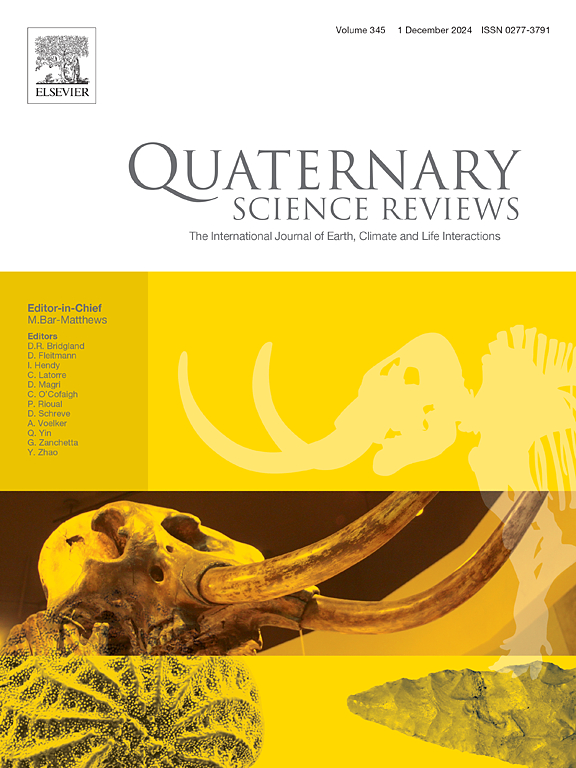Humans exacerbated wildfires in the NW Patagonian archipelagoes over the last 2700 years
IF 3.2
1区 地球科学
Q1 GEOGRAPHY, PHYSICAL
引用次数: 0
Abstract
The onset of human-driven transformations of the landscape, and the functioning of terrestrial ecosystems before and after such onset, remain largely unconstrained in the temperate rainforest region of western Patagonia. Prominent channels and archipelagoes define a fragmented landscape where natural fire activity is rare owing to the hyperhumid, low-seasonality climate, considerable distance upwind from Andean eruptive centers, and sectors with negligible historical human disturbance. Here we examine the role of humans as past drivers of vegetation and fire-regime shifts with a fine-resolution, lake-sediment record from Lago Huillín, located on southern Isla Grande de Chiloé (∼43°S). This is an isolated, strategic sector for modern and ancient navigation throughout the western Patagonian channels located just north of the core of the mid-latitude westerlies. We find a tight coupling between vegetation, fire activity, and westerly wind influence between ∼17.9 and 2.7 ka (ka: 1000 years before present) followed by unprecedented fire maxima between ∼2.7 and 0.3 ka, decoupled from a temperate-hyperhumid regime with uninterrupted dominance of temperate rainforests. This extraordinary condition occurred in the context of enhanced precipitation variability and widespread human occupation over the Patagonian channels in an otherwise fire-suppressed setting, establishing an unambiguous human footprint in a region classically regarded as pristine.
在过去的2700年里,人类加剧了西北巴塔哥尼亚群岛的野火
在巴塔哥尼亚西部温带雨林地区,人类驱动的景观转变的开始,以及在此之前和之后陆地生态系统的功能,在很大程度上仍然没有受到限制。突出的水道和群岛定义了一个破碎的景观,由于极度潮湿,低季节性气候,距离安第斯火山喷发中心相当远的逆风,以及历史上可忽略的人为干扰,自然火灾活动很少。在这里,我们通过位于chilo岛南部(~ 43°S)的Lago Huillín的高分辨率湖泊沉积物记录,研究了人类作为植被和火灾变化的过去驱动因素的作用。这是一个孤立的、具有战略意义的区域,古代和现代的航行都可以穿过巴塔哥尼亚西部海峡,位于中纬度西风带核心的北部。我们发现在~ 17.9 ~ 2.7 ka (ka:距今1000年前)之间植被、火灾活动和西风影响之间存在紧密耦合,随后在~ 2.7 ~ 0.3 ka之间出现了前所未有的火灾最大值,与温带雨林不间断地占主导地位的温带-高湿状态解耦。这种不寻常的情况发生在降水变异性增强和人类在巴塔哥尼亚海峡广泛居住的背景下,在一个传统上被认为是原始的地区建立了明确的人类足迹。
本文章由计算机程序翻译,如有差异,请以英文原文为准。
求助全文
约1分钟内获得全文
求助全文
来源期刊

Quaternary Science Reviews
地学-地球科学综合
CiteScore
7.50
自引率
15.00%
发文量
388
审稿时长
3 months
期刊介绍:
Quaternary Science Reviews caters for all aspects of Quaternary science, and includes, for example, geology, geomorphology, geography, archaeology, soil science, palaeobotany, palaeontology, palaeoclimatology and the full range of applicable dating methods. The dividing line between what constitutes the review paper and one which contains new original data is not easy to establish, so QSR also publishes papers with new data especially if these perform a review function. All the Quaternary sciences are changing rapidly and subject to re-evaluation as the pace of discovery quickens; thus the diverse but comprehensive role of Quaternary Science Reviews keeps readers abreast of the wider issues relating to new developments in the field.
 求助内容:
求助内容: 应助结果提醒方式:
应助结果提醒方式:


